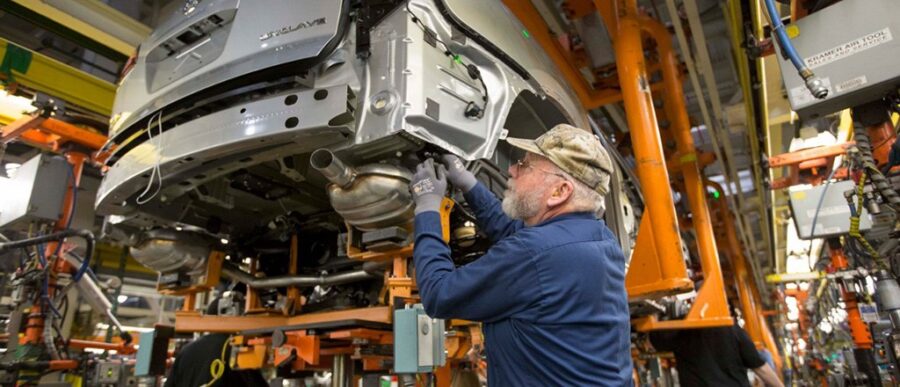The decision earlier this week by General Motors to close five plants in North America, lay off some 14,000 workers, and retire six of its 15 car models is a timely move, and one that will likely benefit the company as it looks to secure its future in the rapidly changing auto sector, experts from Wharton and elsewhere say.
In an announcement, GM said that in 2019, five plants would be “unallocated,” or targeted for possible closure, including two in Michigan and others in Ohio, Maryland and Ontario, Canada. The company hopes to achieve cash savings of $6 billion annually (with cost cuts of $4.5 billion and lower expenditure of $1.5 billion). In addition to the previously announced closure of an assembly plant in Gunsan, Korea, GM said it would also cease the operations of two additional plants outside North America by the end of 2019. Among the car models it would phase out include the Chevy Volt, the Chevy Cruze and the full-size Impala.
GM Chairman and CEO Mary Barra said those actions will enable the company to be “highly agile, resilient and profitable, while giving us the flexibility to invest in the future.” GM made the right decision, according to Marina Whitman, professor emeritus of business administration and public policy at the University of Michigan and a former vice president with General Motors. She noted that GM is facing pressures on multiple fronts: falling demand for sedans as SUVs, crossover vehicles and trucks rise in popularity; increased costs, partly because of the Trump administration’s higher tariffs on imports of aluminum and steel; and the need to allocate investments in developing autonomous vehicles and electric vehicles.
“What [Barra] is doing – looking at it from the outside – is absolutely right for General Motors,” Whitman said. “It’s not a sign of trouble. It’s a sign that she wants to avert trouble, particularly when the next downturn comes, which it will sooner or later.” The closures will no doubt bring pain to affected employees and the local economies around the five plants, she noted. “But it greatly reduces the likelihood of real trouble going forward.”
GM’s restructuring efforts are consistent with patterns in the automobile industry to make adjustments as demand fluctuates, said Wharton management professor John Paul MacDuffie, who is also director of the Program on Vehicle and Mobility Innovation at Wharton’s Mack Institute for Innovation Management.
MacDuffie noted that while consumer demand shifts with business cycles, and there are “signs of a bit of waning of the long recovery, we’re not certainly at a point when the economy’s in trouble.” The company is determined that it should not be caught unprepared when the next economic downturn occurs. In the statement announcing the restructuring, Barra has stressed “the need to stay in front of changing market conditions and customer preferences.”
“What [Barra] is doing – looking at it from the outside – is absolutely right for General Motors.” –Marina Whitman
Consumer preferences are changing in a more significant way in that they are moving away from car ownership, said Erik Gordon, professor at the University of Michigan’s Ross School of Business. “The auto industry is going to be selling fewer cars of any type,” he pointed out. “If it was just demand shifting from one type of vehicle to another type of vehicle, you’d say, ‘Well, let’s make some of the popular vehicles in these plants instead of closing them.’ [Barra is] trying to reduce the overall manufacturing capacity because going forward there are going to be fewer individually owned cars.”
Whitman, MacDuffie and Gordon discussed the factors underpinning GM’s announcement on the Knowledge at Wharton radio show on SiriusXM. (Listen to the podcast at the top of this page.)
MacDuffie has closely watched the buildup to GM’s proposed moves. “The plants being closed have been reducing their production for quite a while now, down from three shifts to two shifts, [followed by] two shifts to one shift,” he said. “These assembly plants are huge and very capital-intensive. To run them at much less than capacity can be a money-losing venture, and so with no sign of demand for the cars made in these plants turning up, I expected some kind of action.”
Changing Demand
The auto industry in general has been responding to increasing consumer preferences for crossover utility vehicles and trucks, and falling demand for sedans, and GM’s selection of plants for possible closure reflects those trends. In October, almost 65% of new vehicles sold in the U.S. were trucks or SUVs, a dramatic shift from trends five years ago when cars accounted for 50% of vehicles sold, according to a New York Times report. Fiat Chrysler Automobiles exited small and midsize cars two years ago, while Ford announced plans to shed all cars but the Mustang sports car in the U.S. in the coming years, the report notes.
At the same time, GM has to embrace “the new industry reality” of the longer-term shift away from internal combustion vehicles towards electric vehicles, autonomous or self-driving vehicles and ride-sharing, MacDuffie said. “Incumbent automakers have to run their legacy businesses in ways that allow them to invest in these new technologies, new business models and all the disruptive changes coming to mobility.”
“With no sign of demand for the cars made in these [five] plants turning up, I expected some kind of action.” –John Paul MacDuffie
The auto industry was not entirely prepared for the drop in demand for sedans. “A bit of a surprise is that the auto industry had turned to making smaller vehicles on the expectation that customers would care more about fuel efficiency,” said Whitman. “But at the moment, they seem to care more about convenience.”
With electric vehicles, too, GM is moving forward. It has identified for phase-out the Chevrolet Volt, which was, as MacDuffie pointed out, “a bridge vehicle for GM getting into an electric design.” While the Volt was retrofitted on existing vehicle architecture to accommodate the electric drive chain, the later-generation Chevrolet Bolt was “the first completely rethought design of an electric vehicle,” he said. While the decade-old Volt can run 50 miles on a battery before it switches to a gasoline engine, the Bolt is fully electric and can go up to 238 miles on a single charge, the New York Times report noted.
According to MacDuffie, U.S. automakers had invested in manufacturing smaller cars a few years back, to ensure their competitiveness in that segment but also on expectations that consumers would prefer smaller cars in a poor economy with the risk of higher gas prices. However, consumers have not exactly flocked to sedans as was expected. “Companies like Honda and Toyota that have strong sedan models in the U.S. market – the Accord and the Camry, respectively – have said that they’re not backing away from those segments one bit.” With GM exiting that market, Honda and Toyota could increase their market share in the sedan segment, “and it may be harder for anyone else to get into the demand that’s left.”
GM is being proactive now, perhaps picking up cues from those earlier misreadings of consumer preferences. “U.S. carmakers have been behind the ball so many times and have been so criticized for it, and it’s hurting them,” said Gordon. “They’ve finally gotten the message, and they don’t want to be left behind again.”
Impact of Tariffs
Few doubt that GM’s cost cutting is related to the Trump administration imposing tariffs of 25% on steel and 10% on aluminum imported from Canada, Mexico and the European Union. Barra did not specifically mention that during GM’s latest announcement, but both GM and Ford pointed to the higher costs from the tariffs when they lowered their profit forecasts in July. While GM said “commodity costs and unfavorable currency in Brazil and Argentina would have a net impact of around $1 billion on its 2018 results,” Ford said the tariffs could cost it up to $1.6 billion in 2018 in North America, according to a Reuters report.
Gordon, however, did not think the tariffs were a factor in GM’s decision to retire five plants. “What led to the plant closings is not that it’s costing more,” he said. “GM actually has reduced costs; GM’s profit margins have gone up. They’ve managed costs quite well, largely because they’re not doing as much discounting.” While GM’s total revenue has fallen from $156 billion in 2014 to $146 billion in 2017, profits fell from nearly $4 billion to losses of roughly the same amount in that period. However, the company has bounced back to profitability with increasing strength in the last three quarters; in the latest quarter ending September 2018, it posted $2.5 billion in profits on revenue of $36 billion.
Gordon agreed that the import tariffs “don’t help [GM] on the cost side,” but he did not think they would lead to so-called “runaway plants,” or manufacturing facilities moved outside of the U.S. “It’s just that the plants that are producing the unpopular cars are not in Mexico,” he said. “They are here in Hamtramck, across the river from where I sit in Ontario, and they’re down in Ohio.”
“A more regional — as opposed to national — logic has come to characterize where [automobile manufacturing] investments are taking place.” –John Paul MacDuffie
Auto Jobs on Decline
GM’s proposed layoffs include 15% of its salaried employees and 25% of executives. GM has said that many of the U.S. workers impacted by its manufacturing restructuring could be absorbed at its other plants that make trucks, crossovers and SUVs.
Automotive jobs in the U.S. are on a secular decline, according to Whitman. “That trend … of a huge decline in automotive employment in the U.S. … has been going on for a long time now, and is going to continue and possibly even accelerate.” She traced that to increases in productivity. “The auto industry in the U.S. until recently was producing more cars than it ever had before with less than half as many employees. The shift to self-driving cars and all-electric cars is going to continue that. It may speed up the shift to reduce the number of employees per car or per 100 cars.”
Electric vehicles have fewer parts and are easier to assemble than the internal combustion engine cars with the transmissions, “and that alone is going to reduce employment on the manufacturing side,” said Gordon. “We’ll have more people doing software and sensors, but you don’t need a ton of them. But a car with fewer parts … inevitably leads to fewer people on the line.” He noted that GM’s plants in Warren, Michigan and outside of Baltimore that have been identified for possible closure “make propulsion systems that will probably not be used 10 years from now.”
How the advent of electric vehicles and autonomous vehicles will impact automotive jobs “is still a bit hard to predict” and will not be the main driver of job cuts, according to MacDuffie. “The switch to electric and autonomous vehicles is no doubt coming, but will be slower than many predict.”
According to MacDuffie, the GM restructuring plan reflected a longer-term trend of automakers preferring to invest in manufacturing facilities. “A more regional — as opposed to national — logic has come to characterize where [automobile manufacturing] investments are taking place.” He noted that the big three U.S. automakers – GM, Ford and Fiat Chrysler – have been locating plants in Mexico for not just small cars, but also SUVs and pickups.
“[Barra is] trying to reduce the overall manufacturing capacity because going forward there are going to be fewer individually owned cars.” –Erik Gordon
Bold Leadership
Whitman saw GM’s latest action as Barra’s attempt to prepare GM for a changed market terrain with electric vehicles and self-driving cars. “This is an attempt to get … ahead of the curve and try to be ready for what Mary [Barra] and many people who follow the auto industry see coming in the way of consumer demand.”
“Mary Barra is the boldest GM CEO in many, many years,” Gordon noted. He described the changes underway in consumer demand as making it a “very tough time” for automakers. “It is not a time to be timid. This is [also] a very tricky time. You have one foot in the manufacturing and sale of what you won’t be selling 10 years from now.” At the same time GM, Ford, Fiat Chrysler and the other auto manufacturers have to make “gigantic investments” in technology and manufacturing facilities for their new electric vehicles, he noted.
MacDuffie agreed that the move is in keeping with how Barra has led GM so far. “She is no longer trying to maintain GM’s strength in terms of size and volume of sales but rather in terms of profitability and agility.”



